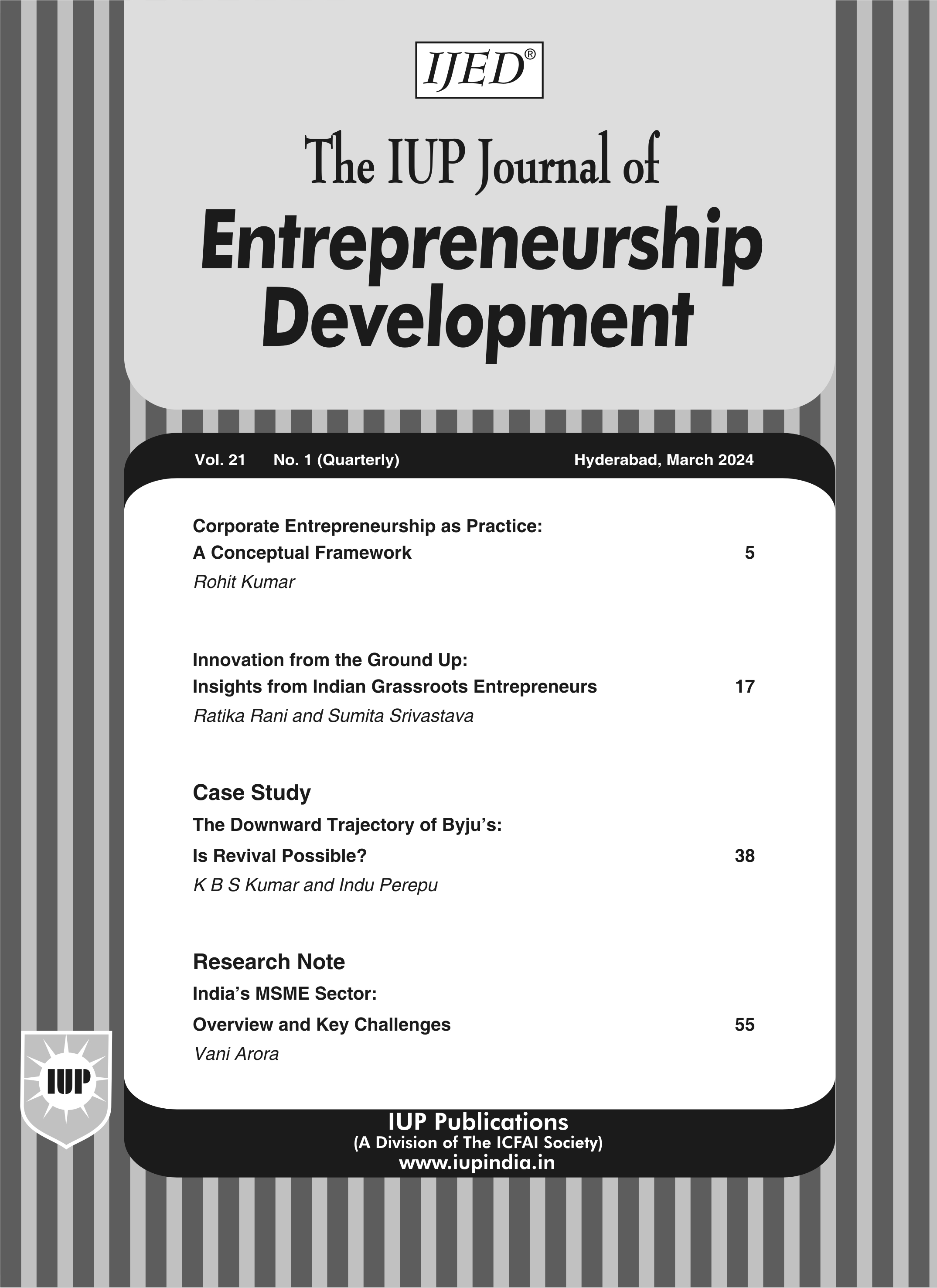
Mar'21
The IUP Journal of Entrepreneurship Development
Archives
Factor Analysis of Sales Performance of Entrepreneurs in Northern Sri Lanka
Shujan Suntharalingam
Agile Product Owner, Affiliation - University of Sri Jayawardenapura, Sri Lanka; and is the corresponding
author. Email id- msshuji@gmail.com
Shahila Yoganathan
Research Executive, Affiliation- University of Colombo, Sri Lanka. E-mail: shahila90@gmail.com
Globally, entrepreneurs are growing day by day, and they have been gaining higher importance with the economic changes in the South Asian Association for Regional Cooperation (SAARC) region as well. In Sri Lanka, during the post-war era, starting from 2010, entrepreneurship phenomenon has grown significantly, cutting across all industries and sectors. This study focuses on the factors that influence the sales performance of the entrepreneurs who run their own businesses in the Northern Province of Sri Lanka. Amidst a population of approximately 5,000 entrepreneurs in the Northern Province of Sri Lanka, the authors selected a sample size of 122 entrepreneurs in the Kilinochchi district and collected the data for the research study. Almost all of them reside in Kilinochchi and conduct day-to-day business operations with the support of their families, neighbors and friends. During the war period, many of the small industries were completely destroyed, and are growing once again. Hence, in this context, the authors have mainly focused on small-scale businesses that have less than five employees, which are mostly household started between 2013 and 2018. Furthermore, the sample data collected from 122 entrepreneurs included both men and women with respective businesses operating within the confines of Kilinochchi district. While analyzing the data collected in line with this study, the authors have defined and elaborated by using the various data analysis metrics and understood that there are three major factors, namely, managerial, financial and psychological factors, that have the greatest impact on the sales performance of the entrepreneurs. Finally, the authors hope that this study will help make decisions for the development and encouragement of entrepreneurs in the war-ravaged districts, while guiding them with proper managerial, financial and psychological support to sustain their businesses effectively in the long term.
Introduction
Entrepreneurs are key players in any developing country, particularly in terms of the
contributions to their community's economic development. Over the last decade, globally it
has been recognized that Small and Medium Enterprises (SMEs) have been the major force
in job creation, innovation and economic development (Shane and Venkataraman, 2000). In the past few years, the status of entrepreneurs in Sri Lanka has been changing due to industrialization, new trends in globalization and changes in the governmental support. In addition, new legislations have been created with laws and by-laws to support a wide spectrum of communities, including women entrepreneurs. As a result, entrepreneurs are encouraged in high level professional activities more and more.
The Northern Province of Sri Lanka comprises five districts - Jaffna, Kilinochchi, Mannar, Mullaitivu and Vavuniya. For this study, primary data has been mainly collected from Kilinochchi district. As per the Annual Reports released by Chief Secretary's Secretariat of Northern Province, the district covers an area of 1237.11 sq km and the average density of population is 170 people per sq km. Administratively, the district is divided into four Divisional Secretariat Divisions (DSD), namely, Karachchi, Kandawalai, Poonagari and Pachchilapalai. Here, most of the residents are engaged in entrepreneurship and cottage industries either full-time or part-time, to sustain their livelihood after the cessation of the Civil War. The types of industries are coir industry, weaving, basket weaving, palmyrah-based production, concrete block making, pottery, agriculture-based industries, hotel industry, rice mill, construction-based industry, garments. Some were employing labor from the local area and providing job opportunities. The number of Rural Development Societies (RDS), which is gradually increasing in Kilinochchi district, also indicates that the number of entrepreneurs who are involved in entrepreneurship is also growing year by year. Entrepreneurs are actively willing to involve in small and medium business to upgrade their livelihood.
Literature Review
Gunawardena and Mudalige (2019), in their study, focused on identifying the factors affecting the growth of social entrepreneurship in the developed region of the country. Altogether 73 social enterprises from Western Province of Sri Lanka were considered as the sample. The research tests six factors relating to small and medium entrepreneurs' successes - government support, impact of access to finance, owner's formal education, strategic orientation, owner's/managers' emotional intelligence and transformational leadership. These factors have been identified as independent variables, while social enterprise growth is the dependent variable. Out of these six hypotheses, two, namely, strategic orientation and access to finance, were accepted, while other four were rejected.
According to the Secretariat of the Northern Province, most female entrepreneurs carry out business activities such as clothing, handicrafts, blending, leather goods, and other small industries, which are very important for women. Rathiranee and Semasinghe (2015), conducted an empirical study on 'Factors Determining the Women Empowerment through Microfinance in Sri Lanka' in order to understand the key factors impacting the empowerment of women in rural areas, through microfinance. This study was carried out in Kilinochchi district of Sri Lanka, and the finding of this study summarized the variables into three factors, namely Decision making, Freedom to mobility and Family support, which are positively associated with Empowerment. Yogendrarajah and Dissanayake (2015) also identified in their research 'A Study on Empowerment of Rural Women through Microcredit Facilities in Sri Lanka', that financially rural entrepreneurs perform well when family support and assistance for managing the business and decision making are found in their surrounding environment.
Marc Thibault (2001) conducted a study on 500 SMEs. To test and evaluate, 16 hypotheses were considered under two main groups as personal factors and business factors to understand the correlation with sales performance. Factors such as gender, age of the owner, education level, total hours worked, previous work experience and business dependency were grouped under personal factors. Meanwhile, other factors such as level of other financing (non-bank), use of technology, bank financing, use of business plan, age of business, geographic location, level of personal funding, business structure, operating location and number of full time employees were considered under business factors. Out of those 16 variables, only gender, age of the owner, business dependency, bank finance, use of technology and number of employees were accepted as influential factors.
In the research study by Jayawardana (2016), key challenges women entrepreneurs face when they start and run business ventures were identified as inadequate resource, management issues and technology. Not only the study found the competencies exercised by the successful women entrepreneur when overcoming the aforementioned changes, the study also identified competencies demonstrated by them into four groups, namely, interpersonal competencies, human relations competencies, entrepreneurial competencies and managerial competencies.
Rani and Hashim (2017), in their study, identified some factors which influenced the women entrepreneurs' success in Malaysia. The study examined the relationship between women entrepreneurial success and entrepreneurial characteristics such as the need for achievement, risk-taking, self-confident and creative and innovation. In their study, Sahut and Peris-Ortiz (2014) discussed how effective small businesses are when it comes to entrepreneurship and innovation, and the importance of commitment and close cooperation between company staff in SMEs.
Objective
The objective of the study is to identify the factors that may influence the sales performance of entrepreneurs.
Research Question
The primary research objective is to identify the factors that affect the sales return of an entrepreneur in the Northern Province.
What are the factors influencing an entrepreneur's sales return?
Research Hypotheses
Below are the hypotheses statements defined for this research study:
Hypothesis 1
H0: Managerial factor does not influence the sales return of an entrepreneur.
H1: Managerial factor influences the sales return of an entrepreneur.
Hypothesis 2
H0: Financial factor does not influence the sales return of an entrepreneur.
H1: Financial factor influences the sales return of an entrepreneur.
Hypothesis 3
H0: Psychological factor does not influence the sales return of an entrepreneur.
H1: Psychological factor influences the sales return of an entrepreneur.
Apart from the above 3-key hypotheses statements on factors that are influencing the sales
performance of the entrepreneurs, two other hypotheses statements were also set in order to
identify demographics-based insights.
Hypothesis 4
H0: μ1 = μ2 (the male and female population means are equal).
H1: μ1 = μ2 (the male and female population means are not equal).
Hypothesis 5
H0: μ1 = μ2 = μ3 (the means are equal among different age categories).
H1: μ1 = μ2 = μ3 (the means are not equal among different age categories).
Data and Methodology
As per the District Statistics Handbook, the population of interest for this study are about
5,000 entrepreneurs in the Northern Province and the sample selected are 122 entrepreneurs
operating in the Kilinochchi district (see Appendix). The attributes of the samples are as
follows:
- Small-scale businesses that are established within the last six years, between 2013 to 2019.
- The ventures with less than five employees, and mostly those businesses are household-based.
- Net sales revenue of the ventures below LKR 100,000 per month.
From the surveys conducted, the authors have identified three key factors, namely, psychological factors, financial factors and managerial factors, that have a greater impact on the sales performance of the entrepreneurs.
- Managerial factor: Risk-taking ability, creativity and innovation.
- Financial factor: Loans from the informal sector, higher interest rate for raw materials/loans.
- Psychological factor: Employee relationship, long-term goal-setting.
Types of Variables
This study is quantitative research and all the research methods incorporated were based on quantitative measures as they were adequately enabled to gather the relevant data. Altogether, six quantitative variables have been considered for this analysis:
- Continuous variable (dependent) - Sales return.
- Ordinal variables (independent) - Psychological factor, financial factor, and managerial factor.
- Nominal variables - Gender and age.
Table 1 depicts the brief information about the type of variables, nature of the sample, data types and test methods used.
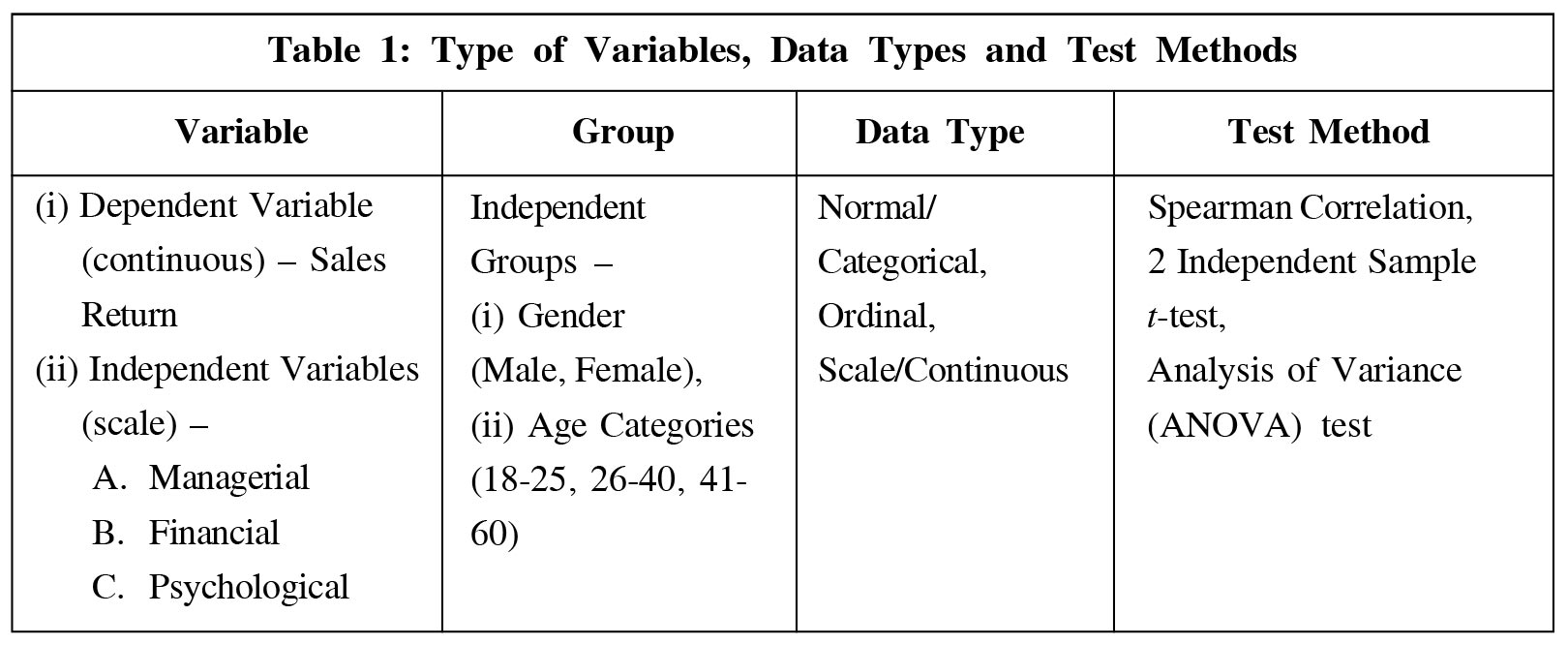
Results and Discussion
Exploratory Data Analysis
Table 2 depicts that around 48% of the sample is the youth population who are less than 40 years old, and the majority 52% are 40 years and above. It also shows that 75% of the sample are male entrepreneurs.
It is evident that the spread of the sales return is very high due to different gender and age groups (refer Figure 1).
Figure 2 shows that there are 4 outliers in financial factor and 1 outlier in psychological factor.
The independent variables, financial factor and managerial factor, have only reached a maximum statistics of 4 with both variables failing to receive a response of 5 (strongly agree) from the sample population under analysis. Comparatively, psychological and financial factors have higher mean values (3.62 and 3.44 respectively) compared to managerial factors (mean: 2.34). This also shows that managerial factor has positive skewness, while psychological and financial factors are negatively skewed. Interestingly, for variables psychological factor and financial factor, mode is 4 (somewhat agree) and mode of managerial factor is 2 (somewhat disagree). This reflects the same in median values as well (Table 3).
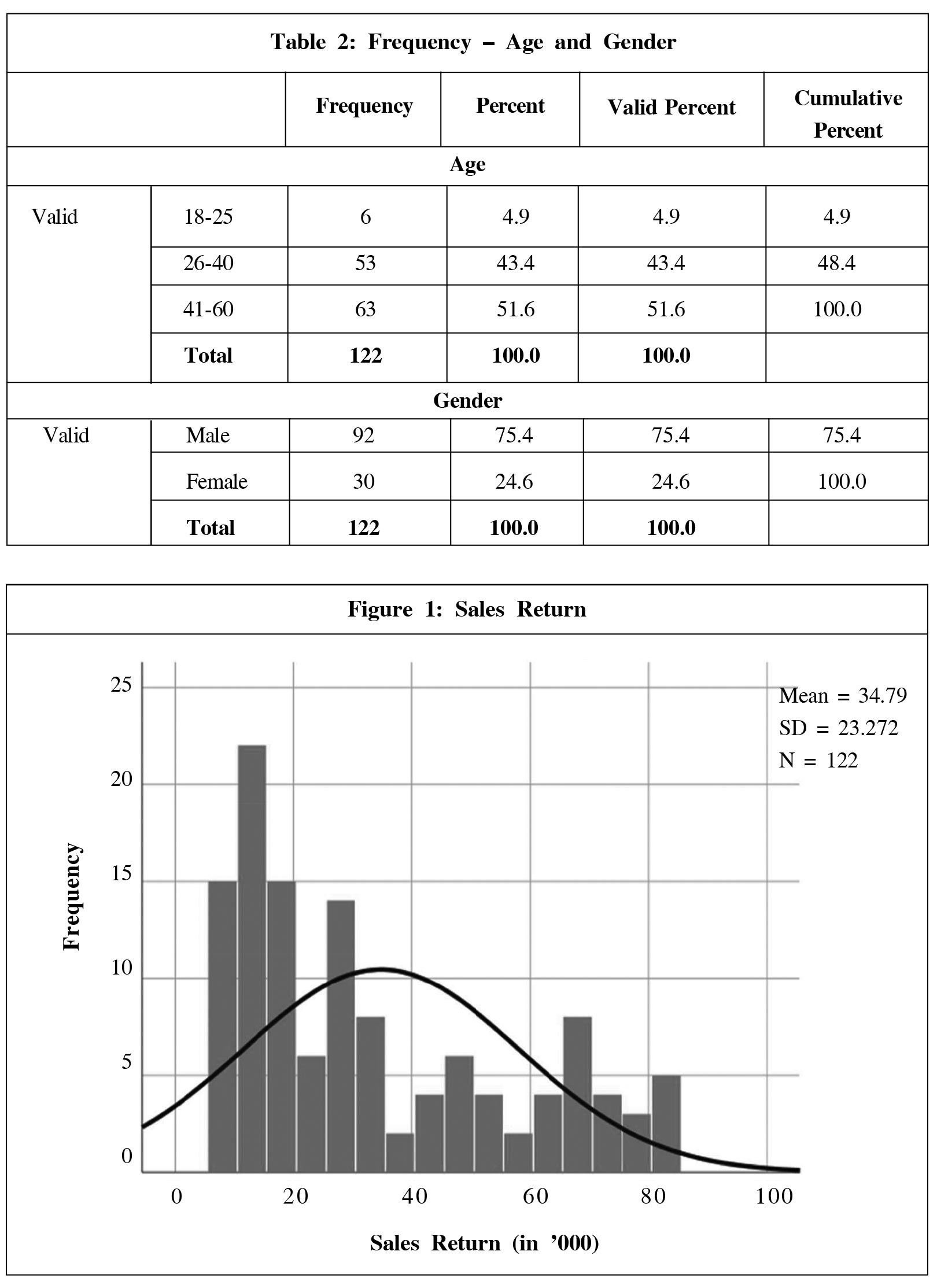
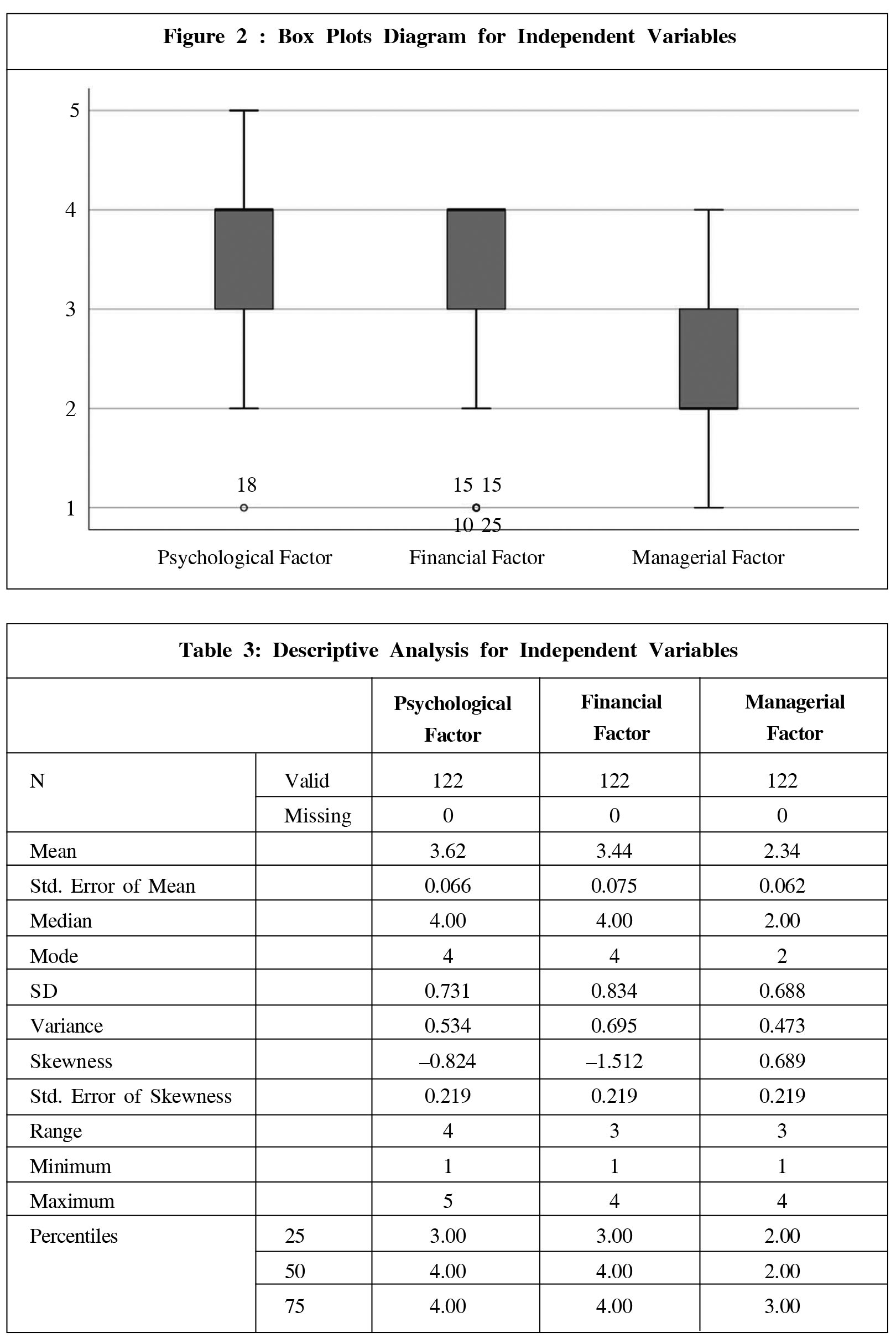
When analyzing the three independent variables individually, it is well understood that for psychological and managerial factors, a majority of the participants were in the state of 3 (neutral) and 4 (somewhat agree). Interestingly, as per the results for financial and managerial factors, only very few participants gave the feedback of extreme scale values - strongly agree or strongly disagree (Tables 4a, 4b and 4c).
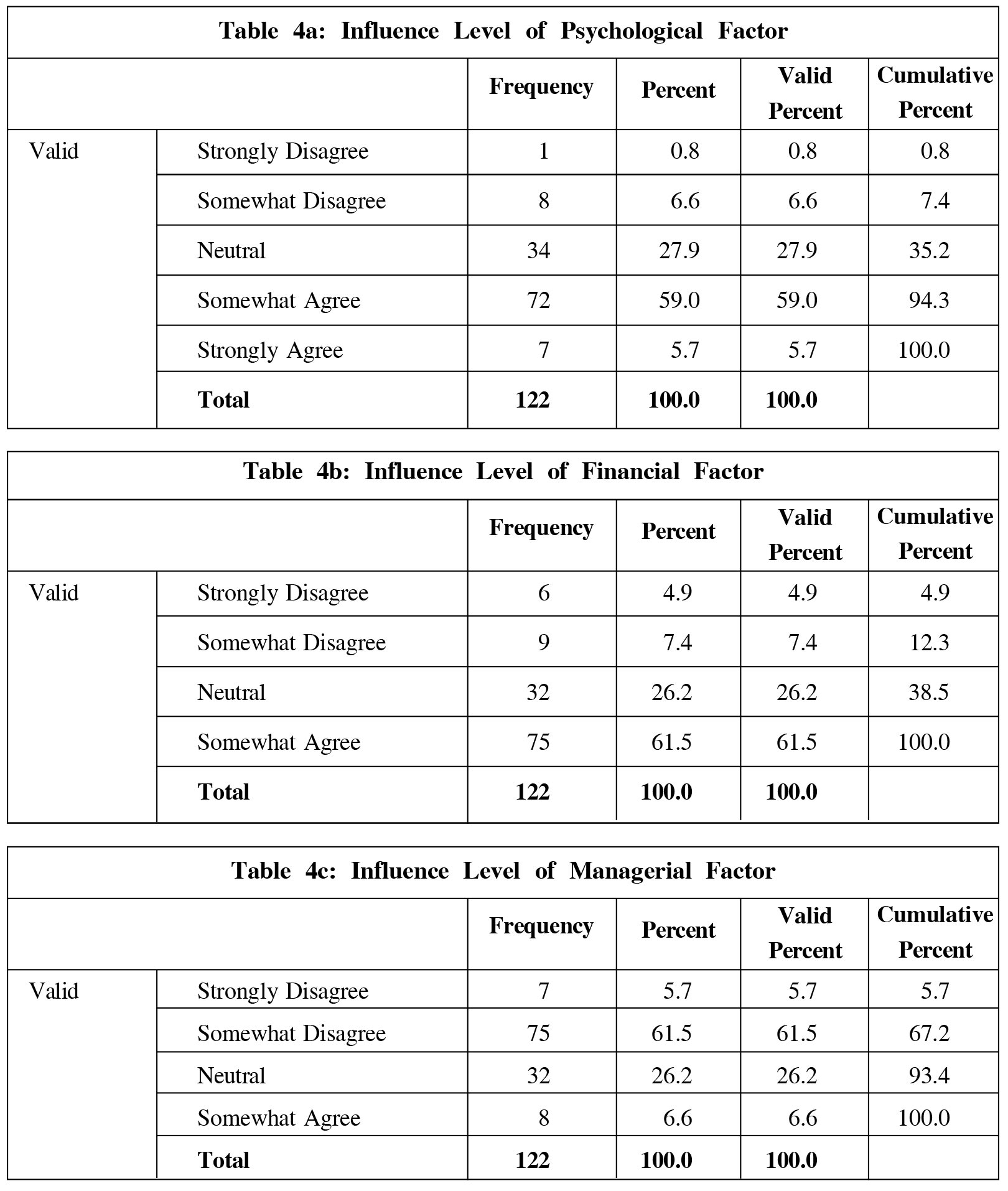
Correlation Analysis Since sales return has nonlinear and monotonic relationship with independent variables, Pearson correlation coefficients cannot be used. Spearman correlation coefficient measure can only be used to determine such monotonic relationships. The scatterplots depict the form of such a relationship (refer Figures 3, 4 and 5).
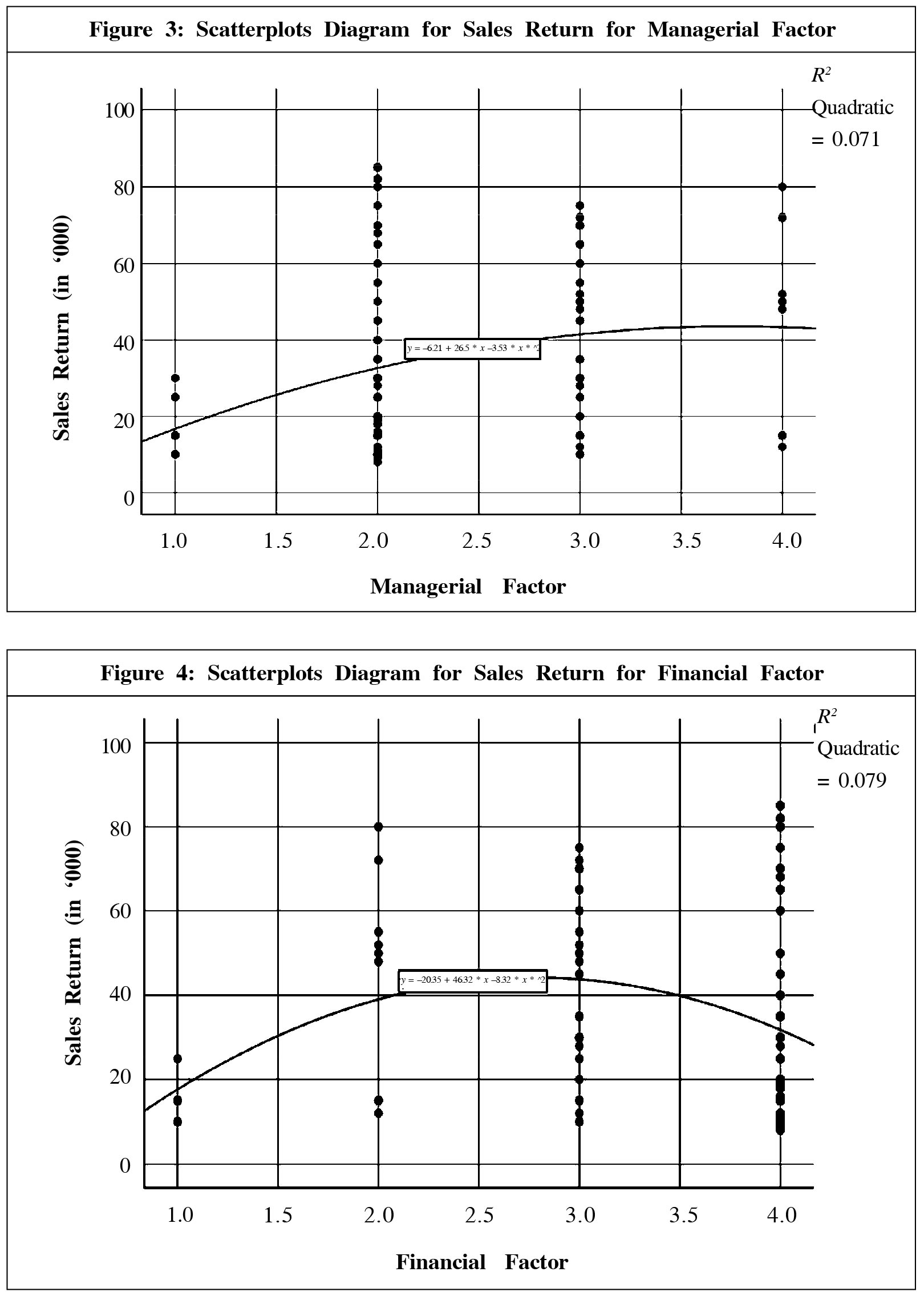
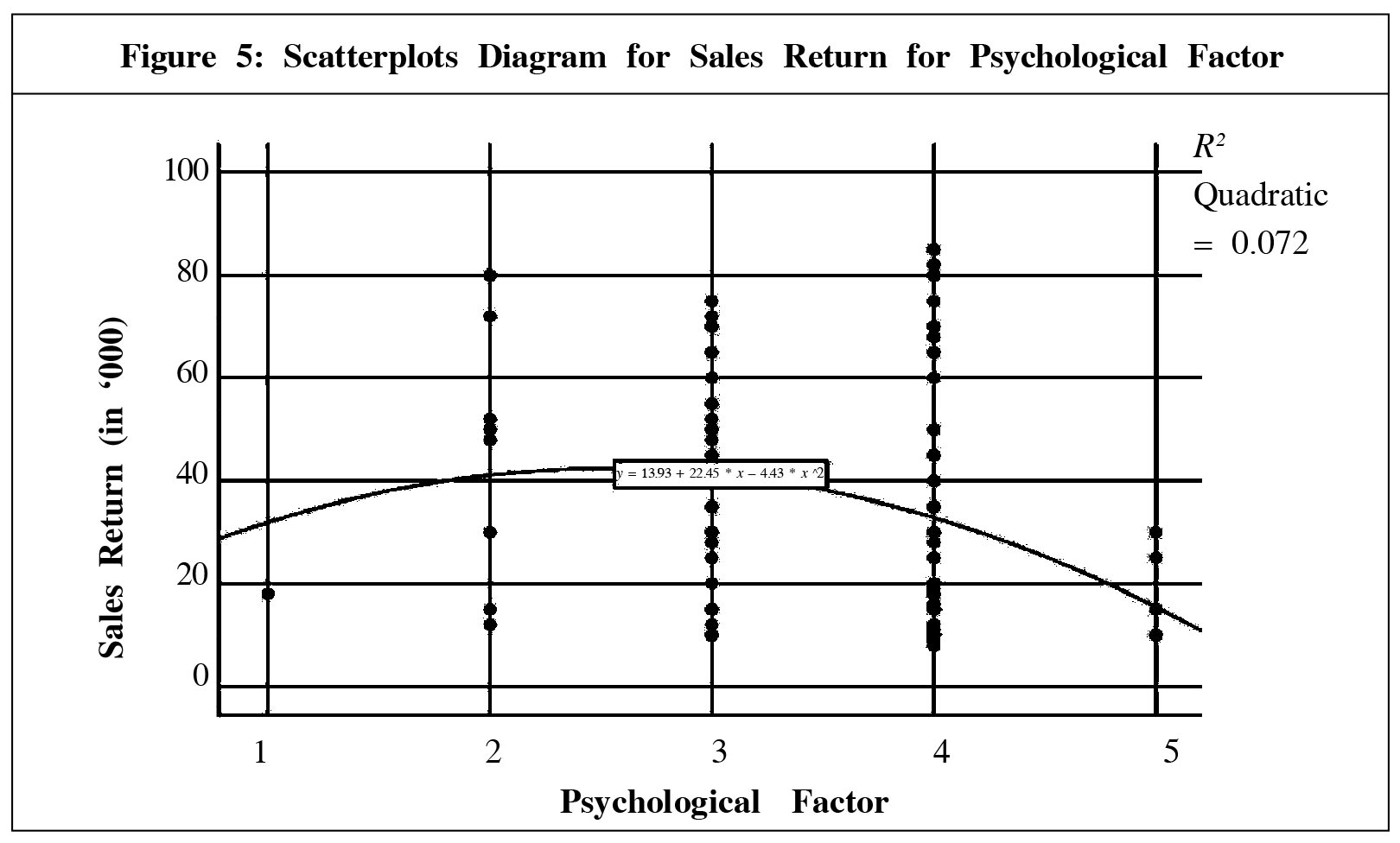
As per Figures 3, 4 and 5, it is evident that a nonlinear quadratic relationship (all the
values are greater than linear) exists.
Since the objective of the study is to identify any kind of correlation (positive and
negative), two-tailed tests were conducted.
As per Table 5 results, psychological factor has negative correlation (-0.268, p = 0.003),
while managerial factor has (0.274, p = 0.002) positive correlation. Interestingly, financial
factor has insignificant impact (-0.117, p = 0.201) on sales return (refer Table 5).
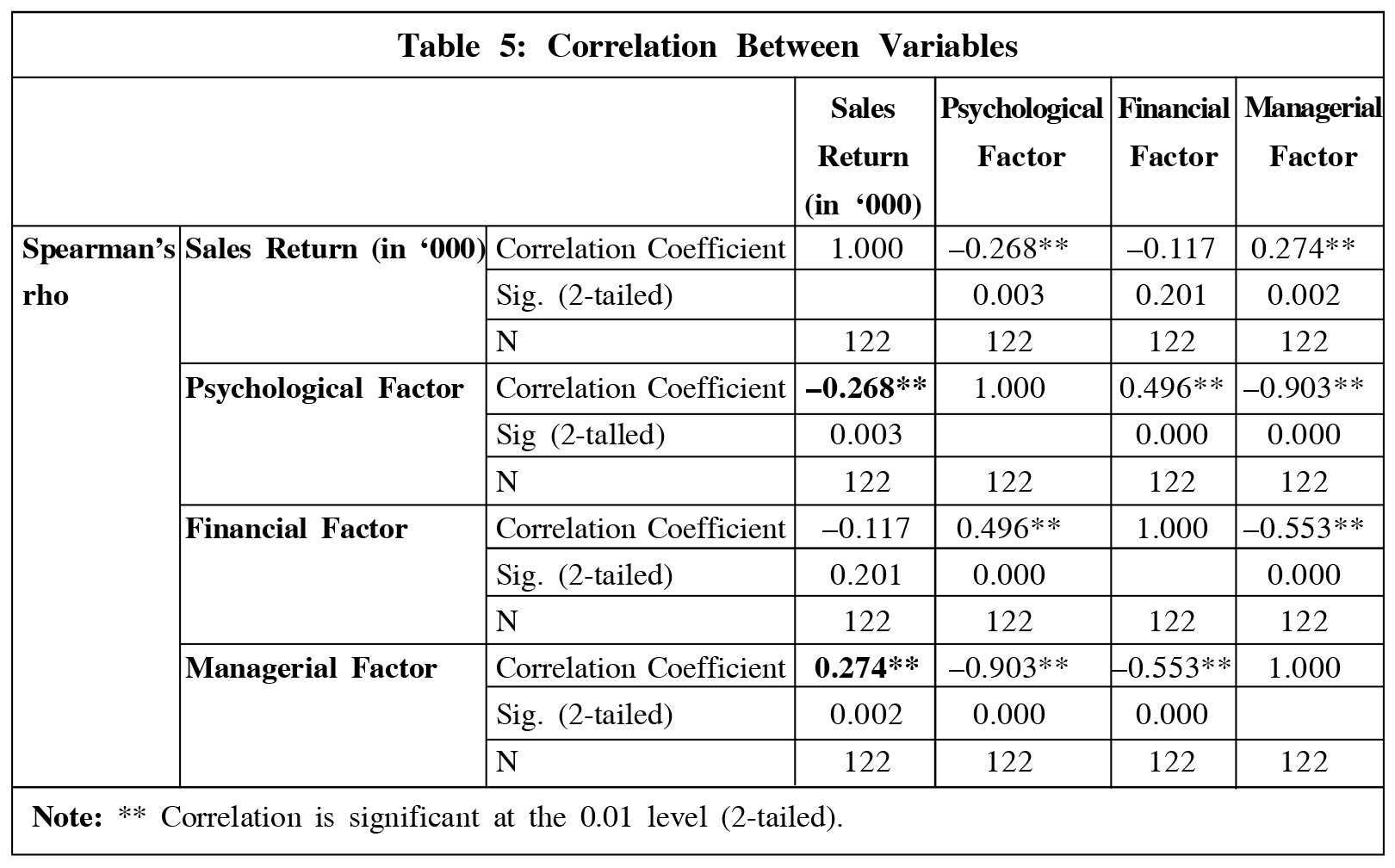
Compare Mean Analysis
Independent Sample t-Test
Independent sample t-test was used to compare the mean of normally distributed continuous
dependent variable sales return for two independent groups - male and female (refer
Table 6).
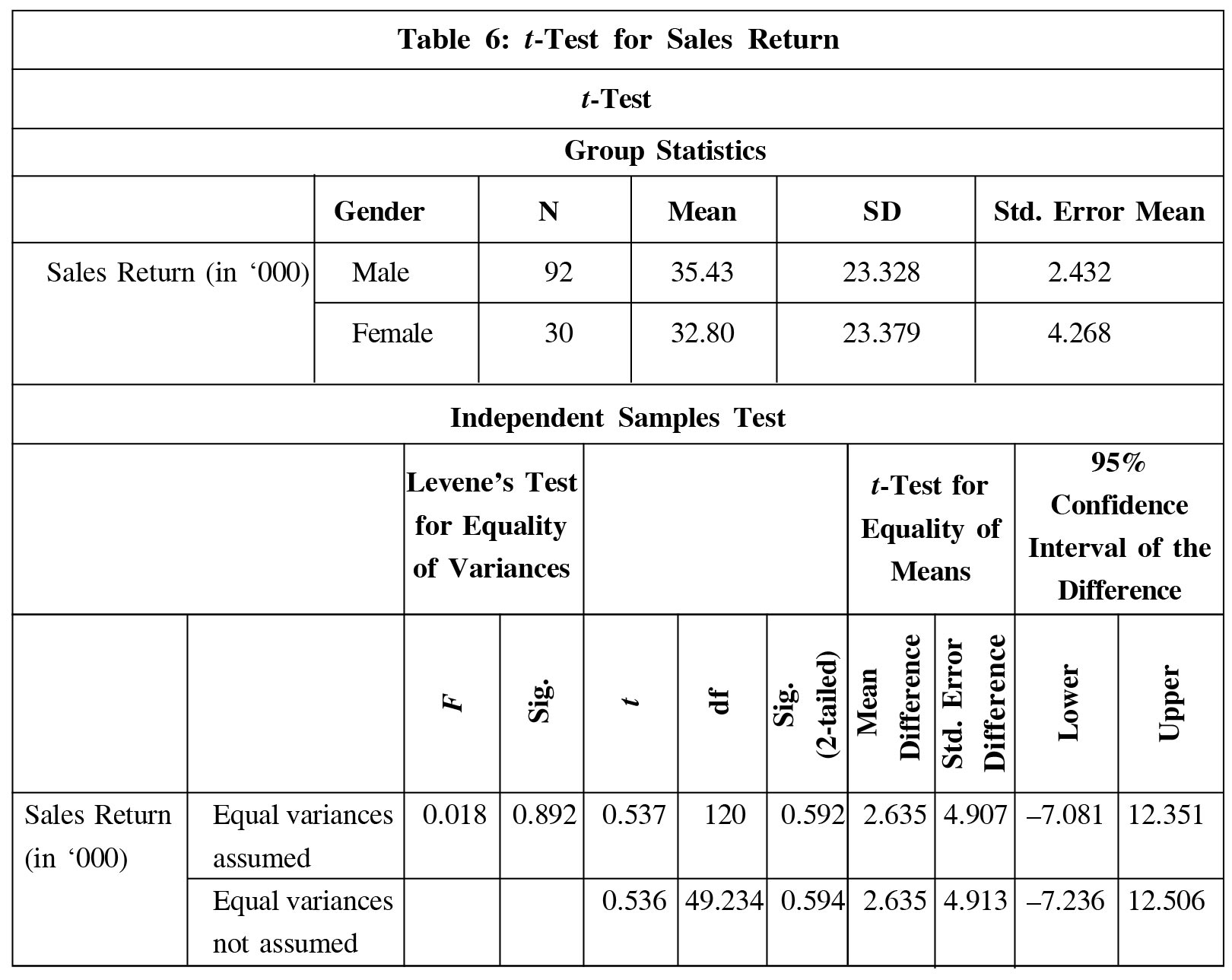
Because the standard deviations for the two groups are similar (23.33 and 23.38), we will
use the "equal variances assumed" test (Table 6). The results indicate that there is a
statistically insignificant difference between the mean sales return for males and females
(t = 0.537, p = 0.592). In other words, females have a statistically lower mean score on sales
return (32.80) than males (35.43).
Analysis of Variance Test
One-Way Analysis of Variance (ANOVA) is used with categorical independent variables (age
category which has three categories) and a normally distributed interval dependent variable
(sales return) to test for differences in the mean of the dependent variable broken down by
the levels of the independent group.
The mean of the dependent variable (sales return) differs significantly among the levels
of age groups (p = 0.048). However, we do not know if the difference is between only two
of the groups or all three groups (Table 7).
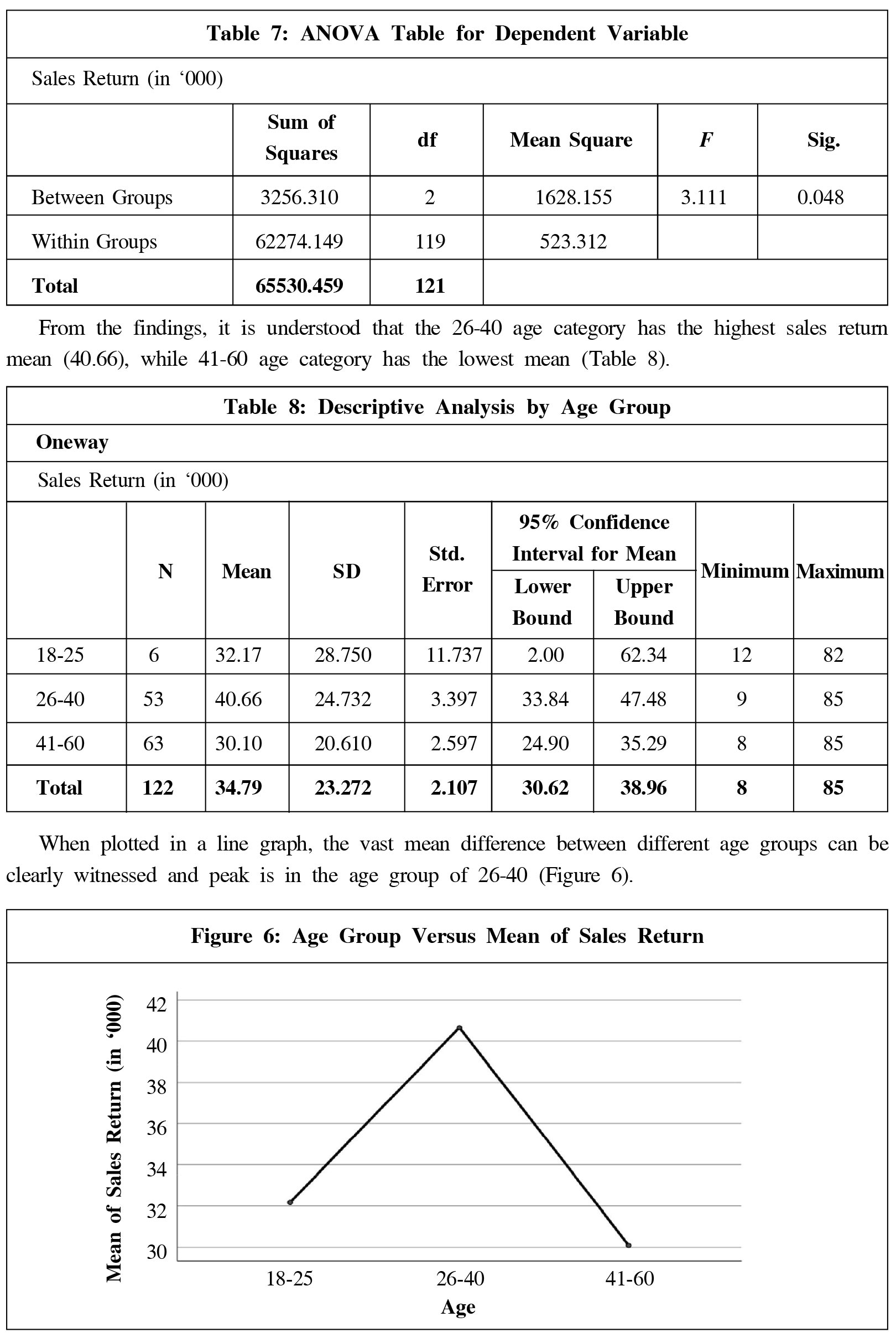
The results of the hypotheses statements derived from the analysis are as follows:
Hypothesis 1
H0: Managerial factor does not influence the sales return of an entrepreneur.
H1: Managerial factor influences the sales return of an entrepreneur.
Managerial factor has (0.274, p = 0.002) slightly positive correlation on sales return.
Hence, we have enough evidence to reject the null hypothesis and accept the claim. So, we
reject H0 and accept H1.
Hypothesis 2
H0: Financial factor does not influence the sales return of an entrepreneur.
H1: Financial factor influences the sales return of an entrepreneur.
Financial factor has insignificant impact (-0.117, p = 0.201) on sales return. Hence, we
do not have enough evidence to reject the null hypothesis. So we reject H1 and accept H0.
Hypothesis 3
H0: Psychological factor does not influence the sales return of an entrepreneur.
H1: Psychological factor influences the sales return of an entrepreneur
Psychological factor has negative correlation (-0.268, p = 0.003) slightly negative
correlation on sales return. Hence, we have enough evidence to reject the null hypothesis and
accept the claim. So we reject H0 and accept H1.
Hypothesis 4
H0: μ1 = μ2 (the male and female population means are equal).
H1: μ1 ? μ2 (the male and female population means are not equal).
The results indicated that there is statistically insignificant difference between the mean
sales return for males and females (t = 0.537, p = 0.592). Hence, we do not have enough
evidence to reject the null hypothesis. So we reject H1 and accept H0.
Hypothesis 5
H0: μ1 = μ2 = μ3 (the means are equal among different age categories).
H1: μ1 ? μ2 ? μ3 (the means are not equal among different age categories).
The results indicated that there is a significant difference in sales return among the levels
of age groups (p = 0.048). Hence, we have enough evidence to reject the null hypothesis and
accept the claim. So, we reject H0 and accept H1.
Conclusion
From the analysis, it is evident that managerial factor has somewhat positive impact on sales
return, contrastingly psychological factor has equally negative influence. Still both these factors contribute to less than moderate influence only. On the other hand, financial factor
does not make a significant impact on an entrepreneur's sales return. Surprisingly, it is
identified that the mean value of sales return of both genders are almost equal, which means
females are equally performing well with men in their businesses. But as expected, there is
a significant difference between different age groups on their business performances.
Limitations:
- This study had a sample size of 92 males and 30 females, which indicates a gender inbalance in the sample selected.
- The age group between 18 and 25 has a lower contribution to the sample size, with no contribution from the age group of over 60 years.
- The samples have been collected from entrepreneurs in the district of Kilinochchi. Other four districts in the Northern Province are excluded from this study.
- There are approximately 4000-6000 SME entrepreneurs in the Northern Province, out of which only 122 were considered as sample in the Kilinochchi district.
- This dataset does not distinguish the commitment of the entrepreneurs-whether they are involved in their businesses part-time or on full-time basis.
- Gunawardena L and Mudalige D (2019), "Factors Affecting for Growth of the Social Enterprises in Western Province, Sri Lanka", available at http://dl.lib.mrt.ac.lk/ bitstream/handle/123/14758/2-01.pdf?sequence=1&isAllowed=y. Accessed on May 26, 2020.
- Jayawardana V (2016), "The Impact of Women Entrepreneurs in Business Development of Sri Lanka", Department of Human Resource Management, 3rd International Human Resource Management Conference 2016, University of Sri Jayewardenepura, Vol. 3, No. 1, pp. 303-316.
- Marc Thibault (2001), "Factors Influencing Sales Performance in Small and Medium- Sized Enterprises in Canada", available at https://www.collectionscanada.gc.ca/obj/s4/ f2/dsk3/ftp04/MQ61953.pdf
- Np.gov.lk. (2017), "Statistical Information - Chief Secretary's Secretariat, Northern Province, Sri Lanka", pp. 40-41, available at https://np.gov.lk/pdf/publications/ Statistical_Information_NPC_2017.pdf. Accessed on June 4, 2019.
- Np.gov.lk. (2018), "Statistical Information - Chief Secretary's Secretariat, Northern Province, Sri Lanka", pp. 15-65, available at https://np.gov.lk/statistical-information- 2018. Accessed on June 2, 2019.
- Rani S A and Hashim N (2017), "Factors that Influence Women Entrepreneurial Success in Malaysia: A Conceptual Framework", International Journal of Research in Business Studies and Management, Vol. 4, No. 1, pp. 16-23.
- Rathiranee Y and Semasinghe D M (2015), "Contribution of Micro Finance in Women Economic Empowerment: An Empirical Study on Jaffna District in Sri Lanka", Caarmel Journal of Management Research, A Half-Yearly Publication, Vol. 3 No. 1.
- Sahut J and Peris-Ortiz M (2014), "Small Business, Innovation, and Entrepreneurship", Small Bus Econ, Vol. 42, No. 4, pp. 663-668.
- Shane S and Venkataraman S (2000), "The Promise of Entrepreneurship as a Field of Research", Academy of Management Review, Vol. 25, No. 1, pp. 217-226.
- Statistics.gov.lk. (2019), District Statistical Hand Book Kilinochchi, available at http:// www.statistics.gov.lk/DistrictStatHBook.asp?District=Kilinochchi&Year=2018. Accessed on May 30, 2019.
- Yogendrarajah R and Dissanayake S (2015), "A Study on Empowerment of Rural Women Through Microcredit Facilities in Sri Lanka", Management Studies, Vol. 3, No. 5, pp. 1595-1599.